“Within the mode of the story the ‘catastrophe’ exemplifies (an aspect of) the familiar words: ‘Forgive us our trespasses as we forgive them that trespass against us. Lead us not into temptation, but deliver us from evil.’ “
-J.R.R. Tolkien, Letter 181
When the new mechanic for Magic: the Gathering’s “Lord of the Rings: Tales of Middle-earth” was revealed, many folks noted that it felt… off. “The Ring Tempts You,” as it appears on roughly 20% of cards from “Tales of Middle-earth” is all upside, when almost anyone familiar with Tolkien’s Lord of the Rings or its many adaptations knows the power the Ring offers comes at a price. Its corrupting influence warps the mind of the user, making them covetous. It grants longevity, but such that the person slowly wastes into a shadow of themselves. And it seems to have a capricious spirit, abandoning its bearer in times of need.
And yet, being tempted is cast as something the game encourages. This, friends, is classic ludonarrative dissonance: the conflict which arises when the narrative of the game’s story is at odds with the narrative produced by the gameplay. When asked about this, Mark Rosewater noted that in testing this mechanic, they had tried other ways to build the mechanic, and wanted to communicate the downside, but found that the addition of penalties, while making the mechanic more flavorful, simply influenced players to not use it. Ironically, this was also a kind of ludonarrative dissonance: the ring is not easily resisted!

However, the “ring tempts you” mechanic was not the only way the Ring and its temptations are represented, and these versions as a whole combine to give us a more robust picture of how Magic has chosen to represent the dynamism of temptation as it occurs in Tolkien’s story. In this article I’m looking at Tolkien’s understanding of temptation in dialogue with the cards of Lord of the Rings: Tales of Middle-earth for the sake of seeing what the game gets right, and what that can tell us.

“Gandalf the White” by Dominik Mayer
A Prayerful Petition
From his letters, it’s readily apparent that Tolkien’s understanding of temptation draws deeply from his own theological understanding of the phenomenon. In discussing temptation, he recalls more than once the petitions of the Lord’s prayer, saying:
“Lead us not into temptation &c” is the harder and the less often considered petition. The view, in the terms of my story, is that though every event or situation has (at least) two aspects: the history and development of the individual (it is something out of which he can get good, ultimate good, for himself, or fail to do so), and the history of the world (which depends on his action for its own sake) – still there are abnormal situations in which one may be placed. “Sacrificial” situations, I should call them: sc. positions in which the ‘good’ of the world depends on the behaviour of an individual in circumstances which demand of him suffering and endurance far beyond the normal even, it may happen (or seem, humanly speaking), demand a strength of body and mind which he does not possess: he is in a sense doomed to failure, doomed to fall to temptation or be broken by pressure against his “will”: that is against any choice he could make or would make unfettered, not under the duress.” – Letter 181
The pull of temptation, Tolkien says, is almost beyond human capacity to resist. There is an air of the supernatural, or Providence, here, the notion that the demands of these situations is beyond what is possible, that we are pushed and pulled by a gravity or a necessity that altogether surpasses our human abilities.
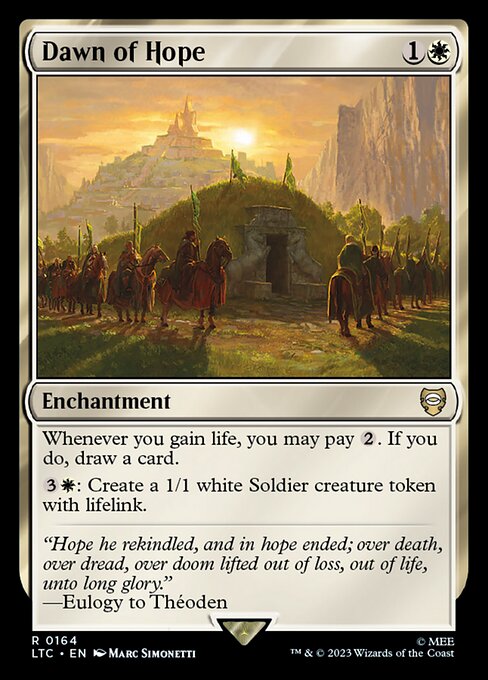
It is important to realize, Tolkien later says, that failure – not virtuous success – is the “natural” outcome, here:
“Frodo ‘failed’. It is possible that once the ring was destroyed he had little recollection of the last scene. But one must face the fact: the power of Evil in the world is not finally resistible by incarnate creatures, however ‘good’; and the Writer of the Story is not one of us“ – Letter 191
Resisting the pull of temptation, according to Tolkien, requires divine grace (cf. Letter 246). It can be hoped for! However, no such mechanic exists in Tales of Middle-earth.
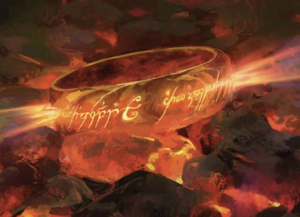
“Fiery Inscription” by John Di Giovanni
The Ring and Ludonarrative
While “The Ring Tempts You” by itself fails to capture the downsides of the ring’s power of temptation, the cards that activate this mechanic nevertheless capture something of its inevitability, and of the power the Ring grants. We see this fleshed out in more detail on certain cards representing Tolkien’s characters:
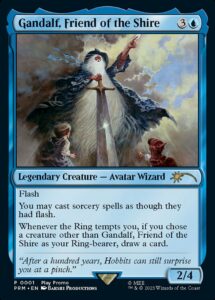
Gandalf, Aragorn, Galadriel, and Faramir all refuse the ring in the narrative, and their cards reward you for recapitulating the choices they make in the story. With Gandalf, Friend of the Shire and Galadriel of Lothlórien, you receive card advantage which also synergizes with limited archetypes (Blue-White draw two and Blue-Green scry), with Aragorn and Faramir, you strengthen your board presence in either quality or quantity. Likewise, canonical Ring-bearers, like Frodo, Adventurous Hobbit or Sauron, the Necromancer, reward your choosing them to bear The One Ring with card advantage or a growing host of wraiths (one of my favorite limited plays), respectively.
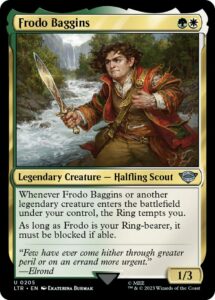
Frodo Baggins (the card), places itself at the center of the game’s action, creating a creature that both must be blocked if able, and is evasive, ensuring negative outcomes for one’s opponents if the Ring has tempted you four or more times. This reflects Frodo’s conspicuous uses of the ring in the Prancing Pony and on Weathertop, and the efforts of Mordor to intercept him at every turn.
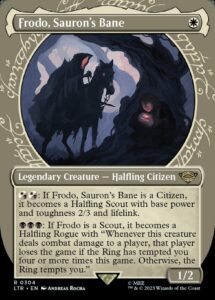
Likewise, Frodo, Sauron’s Bane allows you to take a small, unassuming hobbit and guide him through the stages of his adventure as he grows in power and guile and finally comes to Mount Doom.
In every instance, of course, the only malum of being tempted by the ring is that one’s Ring-bearer suddenly becomes a problem to be solved. Once a player’s Ring-bearer has been tempted twice or more, letting them remain on the battlefield is an unattractive proposition, as they begin to accrue value for their controller every turn. The gaze of the enemy begins to search for them. For a fuller picture of the darker side of being tempted, we have to turn to the cards that represent the Ring of Power itself, and its call: Call of the Ring, Bilbo’s Ring and The One Ring.
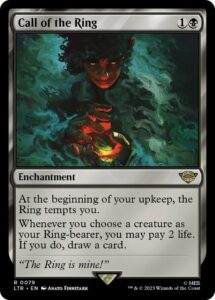
Call of the Ring provides one of the fullest simulations of temptation, providing regular occasions of temptation during each of your upkeeps, and offering the choice to trade two life for a card each time “the ring tempts you.”
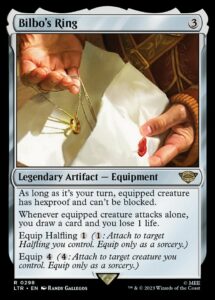
Bilbo’s Ring represents the abilities of the Ring of Power in a way very similar to what I’d initially hoped the ring mechanic would be: it provides hexproof and unblockable when equipped, representing the invisibility it grants its wearer, and it also grants card advantage at the cost of 1 life. However, the protection will not last – it comes and goes, threatening to abandon its bearer as it did Isildur all those years ago.
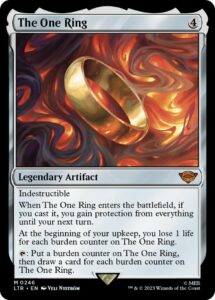
The One Ring does a similarly good job at representing the “draw” of the ring. Casting it grants a whole turn cycle of protection from everything, and the temptation to use its other powers grows once one has activated them once. After all, why should I simply let the burden of Ring slowly drain me if I’ve drawn one card? I’ve taken one damage, shouldn’t I now draw two cards? And now that I’ve taken two damage, I shouldn’t simply go on taking that damage every turn without drawing cards, should I, Precious? No, no, we’ll draw three, Precious, won’t we?
Gollum – er, ahem.
My experience playing all of these cards in sealed and draft is that there is something of the story that is communicated in a fun way through the mechanics. My opponent gunning for my Frodo Baggins, rescuing my Frodo with Samwise the Stouthearted, pondering whether to activate The One Ring to dig for answers, knowing that my deck lacks a way to offset the life loss – all of these create gameplay experiences resonant with certain aspects of Tolkien’s story that I both recognize and appreciate. They are not perfect, but they have been fun.
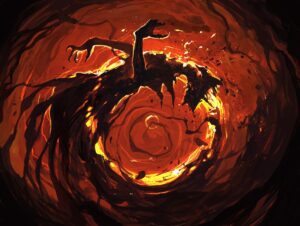
“Sauron, the Dark Lord” by Anato Finnstark and Dominik Mayer
Deliver us from Evil
Perhaps the biggest way that Tolkien’s story clashes with its gamification in Lord of the Rings is not down to any mechanic particular to Tales of Middle-earth at all, but to the premise of the game itself. For Tolkien, the struggle of good against evil, the realities of war, and so on, were tragedies in themselves, reflections of human frailty that would only be resolved with the “final victory.” The gamification of this struggle encourages us to read fun and winning as the ultimate goals – indeed, games must end, and competitive games like Magic: the Gathering have winners and losers. Creatures on the battlefield do not have souls to be corrupted; nothing precious is lost by twisting a halfling into a horror. The story’s ring means much more than that, but any iteration of the game’s “The Ring Tempts You” would strain to begin to approach that.
Nevertheless, Tales of Middle-earth may have done as well as a collectible trading card game could. Taken as a whole, the iterations of the Ring of Power, its bearers, its temptations, and those who resist its call combine to give us a fuller picture of the ruling ring and the nature of temptation. Temptation is subtle; it’s deceptive. One does not simply ignore its siren song. Why would anyone not want to use the ring? It is a gift! There are even myriad ways to offset cards discarded from looting, the loss of life from burden counters, and so on – the game has plenty of ways to turn what looks like a downside into a boon. In a roundabout way, this tells us precisely how temptation functions coercively to lead us down dark paths.
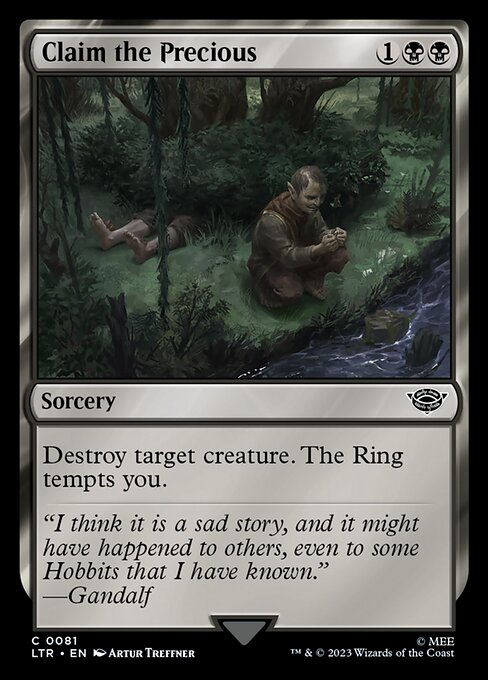
So, in sum, yes, in Tales of Middle-earth there is ludonarrative dissonance… but also something deeply true about temptation and appearances being deceiving, and about the Ring-bearer becoming the center of some negative attention for being so-tempted. For surely, when your opponent targets your Ring-bearer with “Go for the Throat,” they would say, as Frodo once did, “I wish that the Ring had never come to me.”
It’s a good thing I saved that Reanimate.
Suggested Media:
- https://magic.wizards.com/en/news/making-magic/crafting-the-ring-part-1
- https://magic.wizards.com/en/news/making-magic/crafting-the-ring-part-2
- https://www.hipstersofthecoast.com/tales-retold
- The Letters of J.R.R. Tolkien edited by Christopher Tolkien
Jacob W. Torbeck, Ph.D. (he/him) is a researcher and lecturer in philosophy and theology. Jacob hails from the Greater Chicago area, and loves playing Commander and Limited Magic, especially his Old School (93/94) and spooky cubes.

